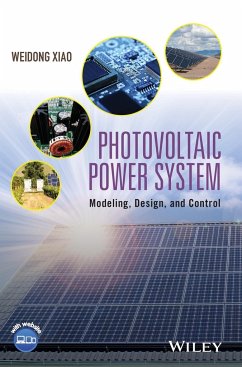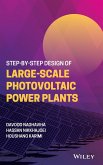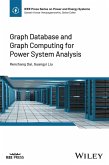Photovoltaic Power System: Modelling, Design and Control is an essential reference with a practical approach to photovoltaic (PV) power system analysis and control. It systematically guides readers through PV system design, modelling, simulation, maximum power point tracking and control techniques making this invaluable resource to students and professionals progressing from different levels in PV power engineering.
The development of this book follows the author's 15-year experience as an electrical engineer in the PV engineering sector and as an educator in academia. It provides the background knowledge of PV power system but will also inform research direction.
Key features:
_ Details modern converter topologies and a step-by-step modelling approach to simulate and control a complete PV power system.
_ Introduces industrial standards, regulations, and electric codes for safety practice and research direction.
_ Covers new classification of PV power systems in terms of the level of maximum power point tracking.
_ Contains practical examples in designing grid-tied and standalone PV power systems.
_ Matlab codes and Simulink models featured on a Wiley hosted book companion website.
Hinweis: Dieser Artikel kann nur an eine deutsche Lieferadresse ausgeliefert werden.
The development of this book follows the author's 15-year experience as an electrical engineer in the PV engineering sector and as an educator in academia. It provides the background knowledge of PV power system but will also inform research direction.
Key features:
_ Details modern converter topologies and a step-by-step modelling approach to simulate and control a complete PV power system.
_ Introduces industrial standards, regulations, and electric codes for safety practice and research direction.
_ Covers new classification of PV power systems in terms of the level of maximum power point tracking.
_ Contains practical examples in designing grid-tied and standalone PV power systems.
_ Matlab codes and Simulink models featured on a Wiley hosted book companion website.
Hinweis: Dieser Artikel kann nur an eine deutsche Lieferadresse ausgeliefert werden.
?This book is an excellent explanation of PV power systems and its controls. It brings sufficient knowledge on modeling and designing different kinds of PV systems (both standalone and grid-tied). In the first 4 chapters, it focuses more on the introduction and PV basics such as PV classification, characteristics, and mathematical models. This information will lead readers to a general understanding of PV fundamentals, providing a smooth transition from basic knowledge to advanced industrial PV applications. It perfectly combines the theory and practical exercises. In chapter 5, it discusses the design, simulates and evaluates of state-of-art system components such as PV-side converters, battery-side converters, and grid-side converters. After discussing the system components, in the next two chapters, the complete dynamic modeling of PV systems are introduced. This book emphasizes the computer-aided analysis and simulation verification. The detailed equations behind the functions are provided, and the simulation blocks used are built using the commonly used blocks in Simulink. Readers can easily follow the step-by-step instructions to simulate the whole PV system in Matlab. Apart from system modeling, the control of the entire PV system like linear control and MPPT technology are also addressed. This book fulfills important demand in both academia and industry. It is also a perfect choice to support teaching senior-undergraduate and graduate courses.? ? Dr. Yang Du, Xi?an Jiaotong ? Liverpool University ?This is a textbook for a course that would appear to be suitable for upper level graduate students. It could also be used by undergraduates and master?s degree level students who want to get a general idea of how solar electric power systems work. The book reads well and should be accessible to most college students and certainly almost all graduate students. In addition to its use for higher education, this book could be used by engineers and utility executives who want to understand the technology of solar photovoltaic systems?It is possible to contemplate using this book to learn about and to teach about solar photovoltaic systems. This is clearly a textbook: it is not a design reference book. With increasing importance of sustainable sources of electric power, there is a clear need to better educate university students about the technology of photovoltaic power. This book should make a serious contribution.? ? James Kirtley, Professor of Electrical Engineering, Massachusetts Institute of Technology ?This book is an excellent choice for beginners working in the photovoltaic industry. It contains a nice mix of industrial applications/examples along with theoretical derivations of photovoltaic system at component- and system-level. The step-by-step discussion on industry background, problem formulation, mathematical modelling, computer simulation, and practical implementation provides a holistic view of designing photovoltaic systems. Detailed simulations modelling the dynamics of individual photovoltaic cell, maximum power point tracking, energy conversion (DC-DC and DC-AC), and grid-level auxiliary services (such as voltage regulation) are also provided. Since the designed MATLAB/SIMULINK block diagrams are provided throughout this book, reproducing the waveforms and results are feasible. In my opinion, this is the most important element? The addition of this book helps students and researchers to quickly grasp the fundamentals of photovoltaic systems. Note that the materials covered in this book are more suitable for graduate students.? ? Jimmy C.-H. Peng, Assistant Professor, Department of Electrical & Computer Engineering, National University of Singapore ?This book provides an inclusive introduction to the field of photovoltaic systems. It covers the basics of PV systems, their classifications, modeling, practical design issues, and their control and operation. It provides in-depth discussions for several modeling and








